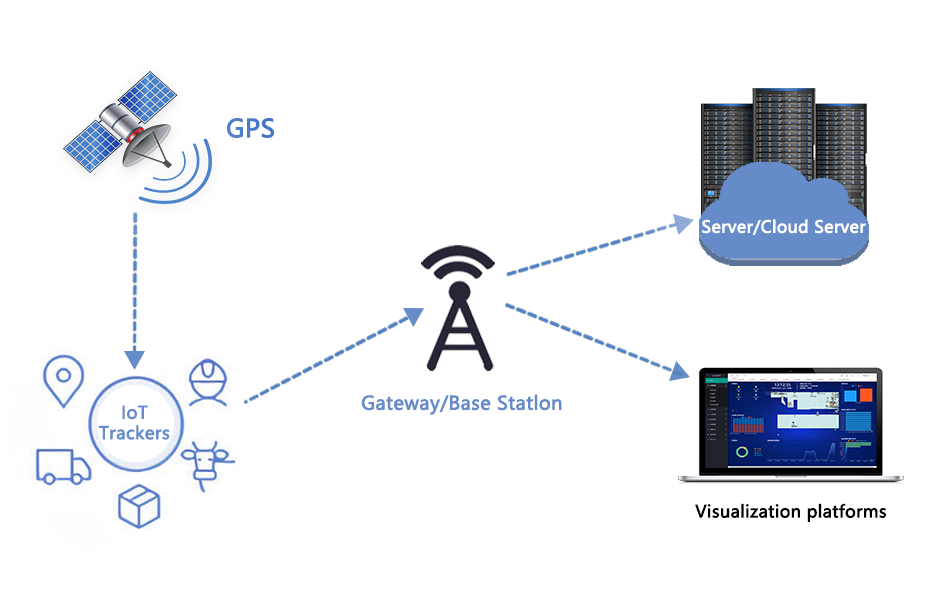Making Wireless IoT Project Easy, Smart, Secure.
GET A FREE SAMPLEThe Internet of Things (IoT) trackers landscape is constantly evolving as technology advances and new use cases emerge. Currently, several key trends are shaping the IoT tracker market. These trends reflect the growing demand for location-based services, asset management, and real-time monitoring across various industries.

1、UWB (Ultra-Wideband) Technology for High Precision Tracking
UWB is gaining significant traction in IoT trackers due to its ability to provide extremely accurate location data, even in dense environments where other technologies like GPS may struggle.UWB provides centimeter-level accuracy for indoor positioning, which is a game-changer for real-time location systems (RTLS). It’s becoming the preferred solution in environments requiring high precision, like manufacturing, logistics, and smart buildings.
2、BLE (Bluetooth Low Energy) and Mesh Networking
BLE has become the dominant choice for asset tracking and indoor navigation due to its low power consumption, affordable cost, and ability to build mesh networks.BLE trackers are cost-effective, easy to implement, and allow for scalable, decentralized networks. BLE-based trackers are increasingly used in industries where energy efficiency and real-time location tracking are critical.
3、Low Power Wide Area Networks (LPWAN)
LPWAN technologies such as LoRaWAN, Sigfox, and NB-IoT are becoming increasingly popular for long-range IoT tracking applications.LPWAN enables low-cost, low-power, and long-range communication, which is ideal for applications where devices need to transmit small amounts of data over long distances, such as in asset tracking or environmental monitoring.
4、AI & Machine Learning Integration for Predictive Analytics
Artificial intelligence (AI) and machine learning (ML) are increasingly integrated with IoT trackers to provide predictive analytics, maintenance forecasting, and real-time decision-making.
AI and ML can transform raw tracking data into actionable insights, providing higher value and helping businesses make more informed decisions. The combination of IoT data with AI-powered analytics enables optimization and automation in industries like manufacturing, logistics, and transportation.
5、Asset Tracking in Supply Chain and Logistics
The demand for real-time asset tracking in the supply chain and logistics sectors continues to grow, driven by increased efficiency, better inventory control, and the need for real-time data to combat disruptions.Businesses are increasingly adopting IoT trackers to monitor assets in real-time, optimize workflows, and improve supply chain resilience.
6、GPS + Indoor Positioning Hybrid Systems
Combining GPS for outdoor tracking and indoor positioning systems (IPS) for indoor tracking is becoming a key solution for hybrid location-based services.The ability to seamlessly switch between indoor and outdoor positioning systems improves continuity in tracking, making it essential for applications requiring constant, uninterrupted tracking of assets or people, especially in large-scale operations.
7、Integration with 5G for Real-Time, Low-Latency Tracking
The rollout of 5G networks is enhancing the capabilities of IoT trackers, especially in scenarios that require real-time tracking, low latency, and high-speed data transfer.5G’s speed and low latency are ideal for real-time tracking of moving assets, particularly in use cases like autonomous systems, where constant communication is crucial for operation.
8、Environmental and Climate Monitoring
IoT trackers are increasingly being used to monitor environmental conditions, providing data on factors like temperature, humidity, air quality, and pollution levels.With increasing concern over climate change and environmental sustainability, IoT trackers are being deployed to monitor environmental parameters in real time, providing valuable data for decision-makers and policy development.
9、Wearable IoT Trackers for Personal Safety
The use of wearable IoT trackers for personal safety is on the rise, particularly in sectors like healthcare, security, and elderly care.With the growing need for personal safety and health monitoring, IoT-enabled wearables are providing real-time data to help respond to emergencies or prevent potential risks.
IoT trackers are evolving with advances in location technology, data analytics, and connectivity. The major trends shaping the market today include the adoption of UWB, BLE, LPWAN, and AI technologies, as well as the integration of real-time data, 5G, and blockchain. These innovations are transforming industries like supply chain, healthcare, agriculture, and smart cities, offering enhanced capabilities for tracking, monitoring, and optimizing operations.
Copyrights© Shenzhen Skylab Co.,LTD All Rights Reserved.

